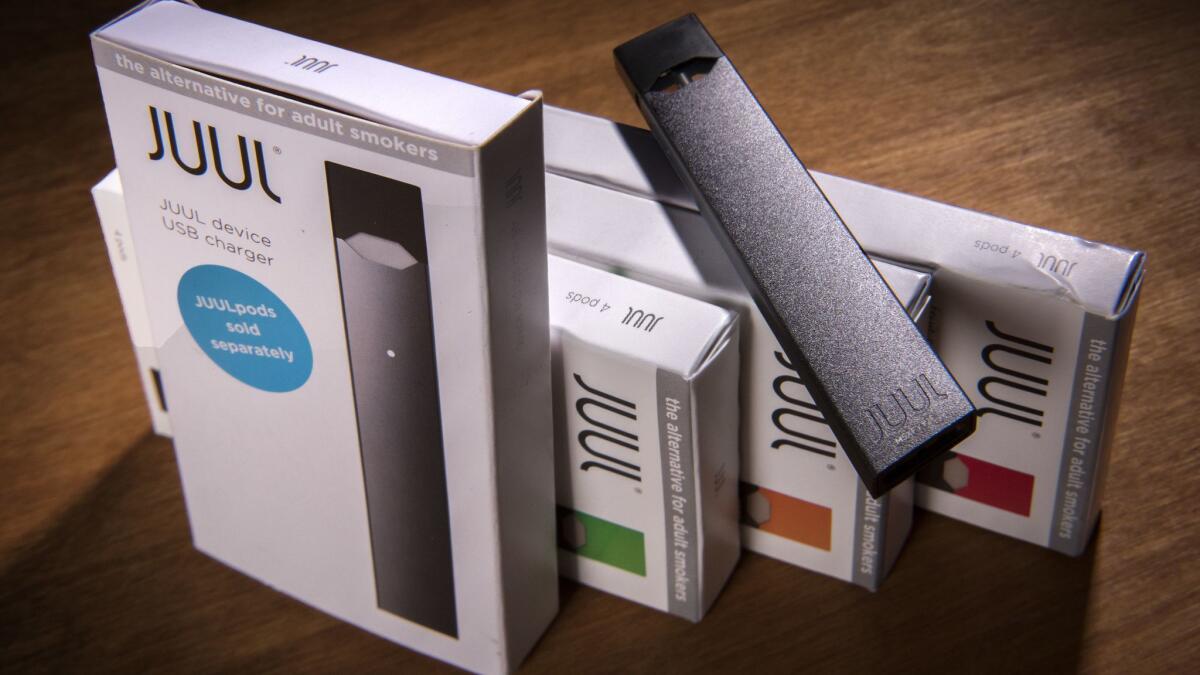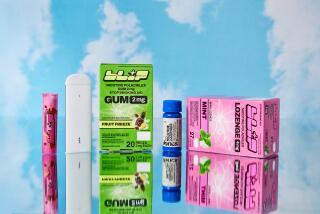Teens say they don’t vape, they ‘Juul.’ That makes the activity hard to track

- Share via
A language gap is making it harder for U.S. health officials to measure a teen-vaping epidemic.
For some young people who use the popular vaping device sold by Juul Labs Inc., “Juuling” is a verb in its own right. Anti-tobacco groups and health officials worry that has led to confusion when pollsters go out into the field to quiz teens on their nicotine habits for an annual government survey that plays an important role in shaping tobacco policies. This year for the first time, the poll will specifically mention Juul as an example of an e-cigarette.
Caleb Mintz, 17, first tried Juul when he was 15 after he saw his friend holding the sleek device.
“Hearing the word ‘Juul’ instead of ‘vape’ makes it sound a lot different,” he said. “It did not look like your typical vape. Giving it a fancy name made it seem like it didn’t have anything harmful in it.”
Mintz didn’t stick with it. He said he saw friends become so addicted that they’d turn to cigarettes for a nicotine fix if their Juul wasn’t in reach. Mintz now considers himself a youth advocate and travels the country with his mother, Meredith Berkman, co-founder of Parents Against Vaping E-Cigarettes, calling for e-cigarette curbs.
The National Youth Tobacco Survey is usually compiled each March through May. The updated survey language is expected to capture kids who think Juuling isn’t the same as using another e-cigarette.
“We suspect that we may see an increase as a result of the more precise language,” said Brian King, deputy director for research translation in the Centers for Disease Control and Prevention’s Office of Smoking and Health. “Most kids are aware of Juul now that it has become a household name, but it has also become so ingrained in the culture that some of them may not know it’s an e-cigarette.”
The CDC conducts the survey with the Food and Drug Administration. Results typically are released late in the year, but preliminary figures may become public sooner.
Youth vaping surged to what government officials last year called epidemic levels. E-cigarette use among high school students rose 78% compared with 2017, reaching more than 3 million students. Last year, the U.S. survey named brands including Imperial Brands’ Blu and Altria Group Inc.’s MarkTen, which the company has since removed from the market, but it didn’t name Juul.
Juul Labs made deft use of social media to popularize its device until pressure from the FDA led the San Francisco company to shut down its U.S. Facebook and Instagram accounts in November. The company has said it supports efforts to raise the minimum age to buy tobacco products to 21.
Juul doesn’t prominently refer to its device as an e-cigarette in advertising but does use the word vapor, including in its Twitter handle. When its Instagram account was active, it often used the hashtag #juulvapor in posts.
Juul spokeswoman Lindsay Andrews said that the company makes clear that its products are intended for adults, and that all carry warning labels about nicotine and its addictive properties. “We follow FDA in calling our products e-cigarettes, electronic nicotine delivery systems or vapor across our various forms of communications,” Andrews said.
As “Juuling” entered the youth lexicon, the Truth Initiative raised concerns that some users may not know what they’re inhaling. The anti-tobacco group found 63% of Juul users ages 15 to 24 surveyed in November 2018 didn’t know the product contains nicotine, a drug that is considered harmful to developing brains. Some users who knew of the nicotine in Juul pods weren’t aware of the potential downsides.
“I’m someone who’s always been fixated with health,” said Sophia, 22, who runs track for a university. She didn’t want to be identified by her full name so her coach and parents wouldn’t know about her Juul habit. Sophia goes through one mint-flavored pod a day, which has the same amount of nicotine as a pack of cigarettes. She said it hasn’t affected her running.
“It’s seen as something that’s addictive, but I don’t know what I’m addicted to,” said Sophia. “It’s been marketed as something not damaging to our health at all.”
E-cigarettes have been hawked as smoking-cessation aids, and the FDA took a go-slow approach on regulating them. However, the surge in underage use and the increasing evidence of the devices’ ill effects forced a shift.
“Everybody, including me, previously thought that an e-cigarette is kind of like a cigarette with less junk in it,” said Stanton Glantz, a tobacco researcher at the Center for Tobacco Control Research and Education at UC San Francisco. But, he said, research is beginning to show that e-cigarettes are “probably about as bad as cigarettes.”
The FDA began to push back last year on the stylized, online-centric marketing by Juul and other companies by spreading messages aimed at preventing youth e-cigarette use. Ads that ran on platforms such as Hulu, Facebook and Spotify warned kids that nicotine could reprogram their brains.
In May, an FDA ad push — part of a $60-million prevention campaign — will hit major television networks, then-FDA Commissioner Scott Gottlieb said at an event before he left the agency April 5. He said that although the FDA had been wary of discouraging adults from using e-cigarettes to help them quit smoking, the youth-use trend “has gotten so worrisome that we’re going to have to now make that trade-off.”
The new ads’ main message will be that teens who vape are more likely to start using traditional cigarettes, FDA spokesman Michael Felberbaum said in an email. Specifics of the media plan, including which networks will air the ads, are still in development, he said.
Still, regulators will need to be agile to track changes in how teens are being introduced to vaping. The CDC’s King said a new e-cigarette called Suorin that comes in shapes including a sleek teardrop device will be added to the survey in 2020. King said Suorin can be refilled with any e-liquid, making it easy to add the marijuana compound THC.
More to Read
Inside the business of entertainment
The Wide Shot brings you news, analysis and insights on everything from streaming wars to production — and what it all means for the future.
You may occasionally receive promotional content from the Los Angeles Times.










